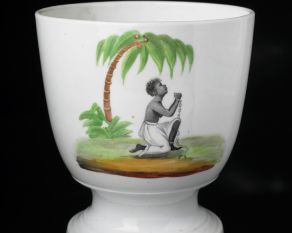

The Rosenbach’s copy of the Letters is especially interesting because this edition was published by Sancho’s son-making the volume the first English-language book to be both written and published by persons of African descent. The book is one of the first known anti-slavery accounts written by a formerly enslaved person. The contents of the book touch on a wide range of topics, from daily life to Sancho’s negative opinions of enslavement.

Sancho’s Letters were published shortly after their author’s death. Sancho, a property holder, was thus the first person of African descent known to have been qualified to vote in parliamentary elections in Great Britain. With help from the Montagu family, Sancho opened a grocery shop in London that granted him, his wife, and children a level of financial stability, and allowed Sancho to engage widely in the artistic and cultural scene in the city. A correspondence with the famous author Laurence Sterne further enhanced Sancho’s status in learned London society. Sancho became well-known in London society circles, especially after sitting for a portrait by the famous artist Thomas Gainsborough-who also painted Sancho’s patroness, the Duchess of Montagu. The Montagus provided him a job as a butler-and, vitally for Sancho’s future prospects, with opportunities to explore the arts, literature, and learning. In an unlikely turn of events, Sancho befriended the 2nd Duke of Montagu, eventually escaping captivity in Greenwich to live with that aristocratic family. The man who enslaved the toddler in the colony of New Granada took Sancho to England and gave him to a family who lived in Greenwich. Sancho was orphaned when he was only two years old.

Ignatius Sancho was born while crossing the Atlantic Ocean on a vessel carrying captive Africans to Spanish colonies in the Western hemisphere, where the captives were sold as enslaved people.


 0 kommentar(er)
0 kommentar(er)
